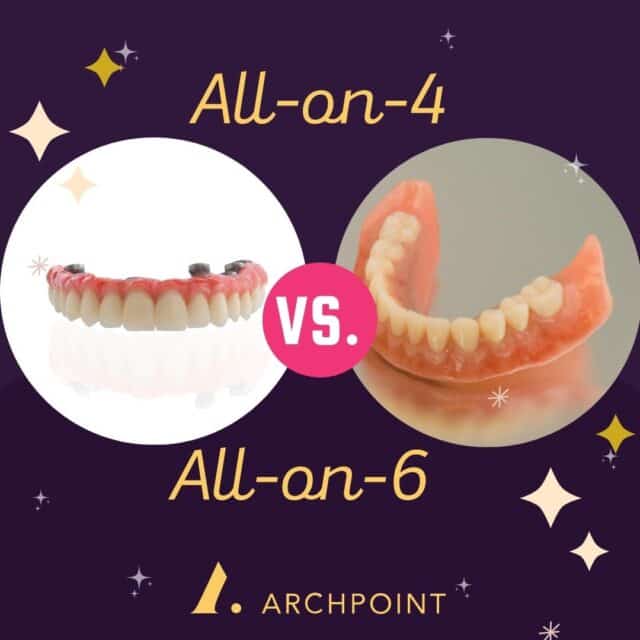All-on-4 vs. All-on-6 Implants: The Breakdown
When you’re looking to replace all of your teeth at one time, an “all on” implant system is an excellent solution to consider. “All on” concepts replace all of your teeth in one arch by anchoring a single prosthesis—such as a streamlined hybrid denture—permanently on top of dental implants.
“All-on-4” implants are by far the most popular. But “All-on-6” is another option to consider.
All-on-4 vs. All-on-6 Implants: What’s the Difference?
What’s the difference between an All-on-4 and All-on-6 dental implant system? If you’re ready to invest in new dental implants but aren’t sure how many or which design you need, it can be helpful to learn more about these two popular choices and the pros and cons of each. Before you make any concrete decisions, always discuss your goals with your implant dentist so they can help you decide which route is best for you!
The main—and really only—difference between All-on-4 and All-on-6 implants is how many implants are being used for the full arch prosthesis. Four is the absolute minimum. But sometimes your bite needs extra stabilization, so additional implants are needed. In this case, six.
Both All-on-4 and All-on-6 dental implants offer patients a way to get back to normal by replacing their missing teeth with minimal surgery and recovery time. Which one is right for you?
All-on-6 Dental Implants
The All-on-6 procedure is ideal for patients who are missing all of their teeth but might not have quite as strong or dense of bone as what we want for only four implants. To maximize your situation, two additional dental implants are added onto what would otherwise be “All-on-4” treatment, turning it into All-on-6.
Since this system uses six implants, it offers additional stability and biting strength for your smile rehabilitation. We can also adjust where each of them is placed, taking advantage of the strong, healthy bone you already have. But from the outside, your smile will look exactly the same as an All-on-4 treatment.
Both All-on-4 and All-on-6 are very strong options for people who have missing teeth. The main difference with adding two more implants is stability; which one is right for you really depends on your oral anatomy and bone health. Our DFW implant specialists will need to fully evaluate your entire mouth and jaws before recommending one or the other for your specific circumstances.
Which Type of Implant Treatment Should I Choose?
If you’re in search of dental implants for a missing tooth, it can be difficult to choose which treatment option is best for you. At first glance, it may seem like all dental implants are pretty much alike—and many people assume that all they really need is one implant to replace each individual tooth. But when you look closer, you’ll realize that there are different types of implant treatments available and each has its own unique features and benefits. In order to determine which type of implant system is best for your unique situation, keep in mind that a lot of it has to do with how many teeth are missing, how long they’ve been missing, and the type of prosthesis you want in the end.
Get A Dentist’s Recommendation
While it’s tempting to do your own research, your implant specialist is an expert on the topic. They will help you determine which type of implant system works best for you and recommend how many implants you need (only 4 or up to 6 in this case).
Working with a team of specialists who have 3D state-of-the-art technology on hand puts you at an advantage. Particularly when it comes to digitally scanning and mapping out your implant placement. With 3D imaging, we can virtually install your implants at various locations to determine the best one. So, if you’re trying to decide if you need 4 or 6 implants, this information can be extremely beneficial. It could mean the difference between “you don’t qualify for dental implants at all” and “let’s use two extra implants to make sure you have the stability that you need.”
Do Two More Implants Matter All That Much?
Going from All-on-4 to All-on-6 implants may not seem like a huge adjustment. But let’s put it into perspective. Say for instance that you have a three-legged stool that you’re sitting on. If you lean one way or the other, there’s a chance it could tilt over. Adding a fourth leg to your stool keeps you more stable when you’re moving around.
Even though four implants are completely fine for a full-arch hybrid device, sometimes we need extra stability for biting and chewing. Especially if we have fewer choices about where those implants can be installed in your jaw. If the installation sites aren’t ideal, adding two more helps stabilize the overall prosthesis so that it can handle normal biting and chewing pressure. That way you can enjoy all of the advantages of implants without regretting your investment.
Consider Your Budget
Do All-on-6 dental implants cost more than All-on-4 implants because of the two additional implants that are being used? It depends. Remember, your treatment fee includes things like sedation, surgical procedures, and your fixed prosthesis. The fee for two extra dental implants might be minimal or nothing at all, depending on the circumstances at hand. The only real way to get a firm idea of how much it will cost is to see your implant dentist and get an individual care plan breakdown. The fee is different for every individual because the process is phased out in various stages to fit the person. It’s not a gimmick to get you through the door and make you feel obligated to get treatment. It’s just that everyone’s circumstances are unique and require a personalized care approach.
DFW All-on-4 and All-on-6 Implants
ARCHPOINT offers both All-on-4 and All-on-6 dental implant treatments in Dallas and Ft. Worth. If you’re still considering your options, we encourage you to give us a call to request an exam. We’ll discuss all of the choices that fit your smile so that you can make a confident, educated choice about your oral health.








